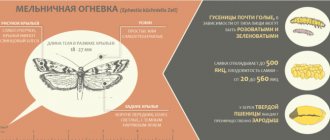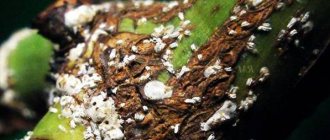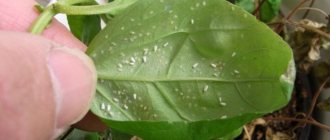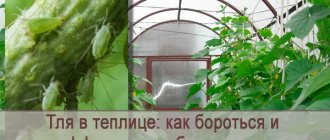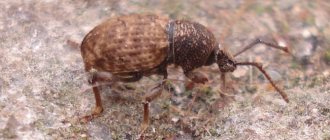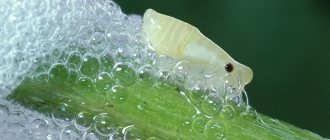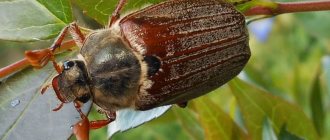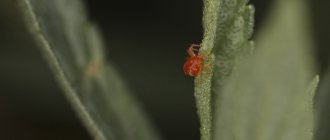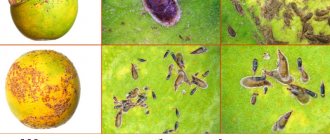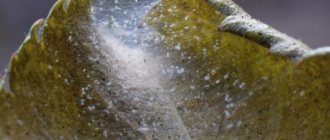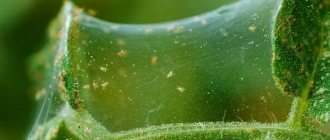is a garden and vegetable pest, small in size, but posing a significant danger to plants if not controlled. The most widespread are pear and apple honeysuckers.
Sometimes it seems that fruit trees in the garden can grow on their own, without requiring any care - you just need to plant the seedlings correctly in a suitable place, and then you won’t have to do anything else. However, it is not.
Fruit trees, especially apple and pear trees, require annual care - watering, fertilizing, pruning and preparation for winter. It is also necessary to protect apple and pear trees from diseases and pests, carry out preventive treatments, and, in case of damage, treat them.
This article will talk about the main pest that affects apple and pear trees - the copperhead or psyllid.
Description of the psyllid
These small insects with a body length of only a few millimeters got their name for their ability to jump, because their hind limbs are similar to the limbs of fleas, which is why these pests can jump.
Also, during their life, a sticky sweet liquid remains on the leaf plates and shoots, which is why this insect got the name “sweetheart”. Photo of copperhead on a leaf:
These pests cause great harm to fruit trees, as they pierce leaf plates and buds with their proboscis and suck out the cell sap from them. Because of this, the foliage and buds dry out ahead of schedule, curl up and fall off.
What damage do these insects cause to trees?
Psyllids are sucking pests. After hatching from the eggs, the larvae crawl along the shoots and feed on the cell sap of the foliage. With their proboscis they bore through young swollen buds and eat young leaves. When the leaves bloom, the larvae are attached to the cuttings or petioles.
The pears on which the psyllid takes root begin to hurt. The foliage from which these pests drink the juice begins to turn yellow prematurely and crumble, and the ovaries fall off. Foliage slows down its development and their area becomes smaller. Traces of the vital activity of copperheads appear on the shoots - a sticky liquid on which a pathogenic fungus begins to develop. In winter, shoots damaged by copperhead will freeze out, and in the summer heat they simply dry out. As pears on such branches ripen, they acquire an irregular shape, and their flesh partially becomes woody.
Read: Winter onions are larger than spring onions
The main signs of the appearance of copperhead on trees
Psyllids may not be immediately visible on fruit trees, since their size is too small. However, the amount of damage caused by these pests can be significant when the insect colony grows large. Therefore, you should know the main symptoms of the appearance of copperhead on fruit trees in order to begin fighting them as early as possible.
The larvae of this pest usually settle in unopened buds - this is where you should look for them in early spring
. And on pear trees, it is the buds that are attacked by adult psyllids.
The main symptoms of the appearance of psyllids on apple and pear trees are:
- since the copperhead sucks the cell sap from the foliage and flowers, when the foliage and buds suddenly turn yellow and fall off in the spring, you can understand what kind of pest has settled on the fruit tree;
- foliage affected by copperhead slows down development and becomes deformed;
- if the copperhead fed on buds, flowers or ovaries, then they begin to dry out;
- deformed fruits form from the surviving ovaries, and their flesh becomes tasteless and tougher than usual;
- Another symptom of the appearance of psyllids on trees is the appearance of a sticky, sweetish liquid on the leaf blades - a waste product of the “harmful” bug. It covers the foliage completely, or accumulates next to the copperhead in the form of small balls. The main danger of this liquid is that it can stick the buds together, preventing the development of leaves and ovaries;
- Apple and pear trees become weaker after an attack by this pest, so they can be affected by pathogenic microorganisms.
Honeydew that appears on leaf blades can become an excellent environment for the development of various pathogens, in particular sooty fungus.
It gradually covers the entire leaf, interfering with the process of photosynthesis.
If sooty fungus moves onto apples and pears, their appearance and taste deteriorate sharply.
Nutrition and harm to fruit crops
Pests are sucking insects. Having left the eggs, they crawl along the branch for some time and, having pierced the bark with their proboscis, drink the juice. Then, having drilled through the swollen bud, they feed on young leaves. After blooming, the leaves are attached to the cuttings or stalks.
Affected trees become sick. The foliage falls off and turns yellow prematurely, and the ovary is lost. The leaves look underdeveloped - their area decreases. On branches covered with sweet secretions of flea beetles, colonies of fungi develop. In winter, damaged branches freeze slightly, and in summer, at the height of the heat, they dry out. The fruits on such trees are irregular in shape and partially woody.
Pests of indoor flowers bring a lot of trouble to gardeners, so it is very important to carry out preventive measures in a timely manner. Are you tormented by flies, are they constantly annoying with their buzzing and are you tired of catching them out of the jam? Then learn everything about anti-fly remedies from this article.
The barn weevil does not disdain anything - it likes any grain. You can find out how to get rid of this pest by following the link.
Varieties of copperhead
There are several varieties of this pest that feed on and damage only certain types of garden and vegetable crops.
apple psyllid
As the name suggests, this “harmful” insect can only live on apple trees, feeding on the cell sap of the foliage. Adult individuals of the apple honeydew lay their eggs in the autumn under the bark near the buds, where the clutches overwinter
. In early spring, larvae hatch from them, move to the top of the bud cone and wait for them to begin to open. As soon as the tips of the leaves or buds emerge from the buds, the larvae of the apple borer crawl inside the buds and eat the foliage and flowers.
Photo of apple psyllid or honey psyllid:
In about 30 days, the larvae turn into adult insects
– this process ends approximately with the end of flowering of apple trees. And adult individuals fly to meadows or tree edges, where their main food is various types of herbaceous plants.
Interesting!
In total, only one generation of apple honeydew appears per season.
Around the second ten days of August, adult psyllids return to apple orchards to lay eggs, which overwinter on the trees so that new pests can be born from them in early spring.
Pear psyllids
This type of psyllid is very prolific - up to 5 generations of these “harmful” bugs can be born during the summer season.
The body of these insect pests of pear is darker than that of the apple honeydew.
Photos of pear suckers
The pear honeydew does not lay eggs for the winter - already fully formed individuals overwinter, which can hide from frost in fallen leaves, bark, and in cracks on shoots.
Fighting the copperhead on a pear - video
As soon as the air temperature rises above 0 degrees Celsius in early spring, these pests awaken from hibernation, and at air temperatures above +10 degrees they begin to lay eggs.
It is important to know!
A female pear psyllid can lay more than 1,000 eggs at one time.
Carrot suckers
If there is a pine or spruce forest next to a garden or vegetable plot, then from there a carrot psyllid may fly to the cultivated plants. This pest is smaller than other types of copperhead
- its light green body can reach only 1.5 mm in length.
Insects emerge from hibernation in early spring and at first feed only on the needles of pine and spruce trees. And in the second ten days of May, carrot suckers move into the gardens into beds with young carrot shoots.
In the last ten days of May, the females of these insects begin to lay eggs, which are attached to the back of the carrot tops or to their petioles. Each female can lay up to several hundred eggs
.
After about 20 days, the larvae hatch from the eggs, which become adults after 30 days.
Important!
The carrot sucker species produces only one offspring per season.
Pear
The most common pest among other types of psyllids. The insect that appears in summer is reddish-orange, in winter it is brown and dark. When the air warms up to +3C, the insect wakes up and begins to eat intensively; at +10C it lays eggs. One generation has up to 1200 pieces!
In the southern territories, the female produces 5 generations per year, in the northern territories - 3-4. The drier and hotter the climate, the more fertile the female and the faster the maturation of the egg.
Folk methods of dealing with psyllids
In early spring, before the buds begin to bloom on fruit trees, the crowns of apple and pear trees should be treated with infusion of tobacco
or
yarrow
.
To prepare tobacco infusion
, you should dissolve 200-250 g of tobacco residues in a bucket of water and leave to infuse in a warm, dark place for 24 hours. Then the resulting infusion is filtered, poured into a sprayer and treated with fruit trees.
An infusion of yarrow to combat copperhead is prepared as follows:
dry leaves and stems of yarrow are crushed and poured into a bucket, filling it about 1/3, then water is poured to the top of the bucket and left to infuse for at least a few hours. Then the solution is filtered, and the trees are treated using a spray bottle or sprayer.
You can also use a soap solution
or
infusion of wood ash
.
To prepare a soap solution, dissolve a bar of laundry soap in a bucket of water.
. Treat all shoots with the resulting liquid before buds begin to bloom.
The infusion of ash is prepared as follows:
200 g of ash are dissolved in a bucket of water and left to infuse for a day, stirring the mixture periodically. Then the infusion is filtered and fruit trees are sprayed against copperhead.
Adult psyllids can be controlled with tobacco smoke.
. To do this, large piles of hay or dry grass are laid out around the garden, on which tobacco waste is laid (up to a couple of kg for each pile). Then the hay is set on fire and the trees are fumigated. This procedure should be carried out over several hours.
To protect carrot plantings from the vermin pest, the following procedures should be carried out:
- after planting the planting material, the bed must be covered with polyethylene or any non-woven material for a while until shoots appear;
- After sprouts appear, the beds should be covered with sifted wood ash mixed with tobacco dust. To ensure that this mixture remains on the carrot leaves, it is better to carry out this procedure early in the morning, while there is still dew on the plants.
If psyllid pest larvae appear on carrot seedlings, you can treat them with tobacco infusion, which is prepared in the same way as for treating fruit trees.
However, it must be remembered that folk remedies against honeyweed are effective only when the number of pests on cultivated plants is small
. If the copperhead colony has grown, then you will have to use solutions of insecticidal preparations to combat this pest.
Use special medications
| Bitobaxicillin and other biological drugs Their main advantage is safety. They do not harm humans and the environment. Therefore, you can apply as many times as you like, the main thing is to maintain the intervals specified in the instructions. They do not act immediately, but within a week . And this is the main disadvantage: it is impossible to evaluate the effectiveness immediately. Can be used without special restrictions | |
| Actellik and other insecticides Universal products that are used to control various garden pests. Much more powerful than the previous version, but also more dangerous. Use according to instructions, follow safety precautions . Always use protective equipment to prevent any problems. It is better to use once . That is, if you sprayed it once, then the next treatment is carried out with a different insecticide so that the pests do not develop immunity | |
| Bazudin and Phosfamide Powerful products that effectively destroy almost all caterpillars in one treatment. They are used in cases of significant damage and when emergency measures are required. Use strictly according to the instructions, in no case violate the proportions . Even a properly prepared drug often causes leaf burns, and in case of an overdose, you can simply burn the tree | |
| Zolon Another powerful tool. But it has a softer effect on the green part. Chemical burns do not form on the leaves. Refers to poisons . Therefore, compliance with safety precautions and strict adherence to the instructions on the packaging are mandatory. |
Chemicals against copperhead
To cope with a large number of psyllids on cultivated plants, you need to use certain insecticidal preparations.
To destroy the colony of this pest on garden and vegetable crops, you should use solutions of the following insecticides against the copperhead: Karbofos, Phosfamide, Metaphos or Thiophos.
However, such insecticidal preparations are slightly toxic to humans, but can be destructive to beneficial insects, in particular bees. Therefore, treatment with such means is prohibited during the flowering period of fruit trees.
. It is also not recommended to treat gardens with insecticides that are located near water bodies, so as not to kill aquatic inhabitants.
Flower beetles, honey beetles, leaf rollers, codling moths - video
Reviews from gardeners
Yuri, Penza
The apple moth is such a pest that it can entangle the entire tree in its web. Spraying with poisons helps, I sprayed, but I don’t remember the name of the drug - ask at garden stores.
Source: dacha.wcb.ru
Ivan, Vologda
Pay attention to Fastak. It is poorly washed off by rain (because it does not dilute well in water). Works instantly. Affects the pest at any phase of its development. Used in small doses. Not dangerous for warm-blooded animals.
Source: forum.vinograd.info
Preventive actions
First of all, you need to strengthen the immunity of fruit trees, because strong, strong apple and pear trees are practically not susceptible to attacks by pests
. To do this, you need to regularly apply fertilizing containing nitrogen, phosphorus and potassium to the tree trunk circles throughout the season.
In the autumn, mandatory sanitary pruning of trees is carried out, removing all damaged, dry or diseased branches, and also cutting off old bark and moss from trunks and shoots. Fallen leaves are removed from the tree trunk circle. All plant residues should be immediately burned off-site.
Despite its small size, the copperhead can cause great damage to apple and pear trees.
– it deprives the foliage of cellular sap, as a result the leaves die, the affected buds and flowers may also die, causing the yield to drop sharply. Therefore, it is necessary to begin the fight against this pest immediately after traces of its presence on the trees are detected.
Prevention
Prevention is the best measure to combat the pear borer and its apple relative. If you prevent the spread of pests in the garden, there will be no one to destroy.
The main preventive control measures should be considered and applied in practice, the following:
- Timely pruning of fruit trees with the obligatory removal of thickening, damaged and dry branches.
- Cleaning the bark of trees from lichens, mosses and other alien growths.
- Harvesting remaining fruit from trees before winter.
- If pears are infected with honey worms in the summer, the litter under them should be collected in late autumn and burned along with the wintering insects.
Lifestyle
Pear honeydews live in colonies. The main activity of parasites occurs in the evening and at night. They prefer hot and dry weather. If it's cloudy or cool outside, psyllids look for warm shelter. Eggs and larvae that do not have time to turn into adults die with the onset of cold weather.
Colonies of psyllids are often surrounded by foraging ants. These insects exist in symbiosis, like with leafhoppers or aphids. Ants help honeydews to overwinter, and they, in turn, provide food. In addition to pear trees and apple trees, psyllids settle on black currant bushes. Their foliage becomes covered with piebald spots, and a sooty fungus develops on the berries.
